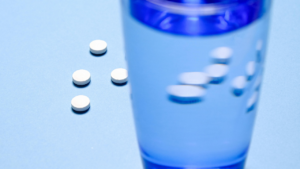Meth, also known by its longer name of methamphetamine, is a very powerful stimulant. A stimulant is a specific category of drugs that has direct effects on your body’s central nervous system. It’s also responsible for an unpleasant condition known as meth sores.
If you suffer from meth sores and need meth addiction treatment, call us today at 330.919.9228.
What Are Meth Sores?
Meth sores are areas of open wounds that may appear on a person’s face, mouth, chest, and arms. Although many people might just think of sores on the face or lips, they can actually appear anywhere on the body, though they are more typical on the face.
These sores are a side effect of repeated meth use. A one-time or occasional use of meth is not likely to result in the development of these sores, but consistent use over time will result in meth sores in the user. The sores appear red and may be mistaken for acne, an allergic reaction, a bug bite, or a rash.
Sores are not necessarily always infected, but as is typical with habitual drug misuse, users tend to pay less attention to personal hygiene or nutrition. As hygiene, proper cleanliness, and nutrition is neglected, the likelihood of the meth sores becoming infected rises. Infected sores invite bacteria into the body and can lead to complications, especially if the bacteria reach the bloodstream and spread throughout the body.
Dermatological treatment and other specialized medical care may be needed for an effective full recovery from meth sores.
What Do Meth Sores Look Like?
Meth sores can appear in a variety of places on a user’s body. We will examine some of the most common locations for meth sores to appear. Some meth sores are created through repeated itching and scratching at one location on the skin. Other meth sores are created through the method of using meth.
The variety of reasons a user has meth sores can include:
- Burns from paraphernalia (such as a pipe for crystal meth)
- Weak immune system from continued substance use
- Acne
- Continuous picking at sores or irritated skin
- Infection
Meth Face Sores
Meth, as we have previously noted, can be dissolved in water. This means that it is water-soluble. A frequent meth user can sweat meth out of their pores. By having this meth-laced sweat sit on the face, sores can appear and irritate the skin.
Meth sores on the face look very similar to an acne outbreak: red and bumpy. Users may find these spots uncomfortable and frequently pick at the sores, causing them to rupture and become open wounds. Open wounds are an ideal breeding ground for bacteria and harmful germs. Continuous picking at sores can lead to infection and other complications.
Meth Mouth Sores
Meth sores can form around the mouth are usually caused through the use of crystal meth. Crystal meth is most commonly smoked through a pipe. During the process of smoking through a pipe, the pipe can become very hot and burn the lips and skin that surrounds the mouth.
These burns can also be painful and have the potential to be a hazard to a person’s health. Like many other kinds of burns, blistering skin can be highly uncomfortable and can result in some scarring or permanent marks. Burns and sores that fail to heal properly can pose a threat of infection.
Meth Skin Sores
Habitual meth use can restrict the flow of blood vessels. When blood vessels are constricted, the result can turn out as dry and scaly patches of skin on the face or arms. Like all the other places on the body where you can find meth sores, skin sores can be picked at. Picking at those patches of sores or irritated skin will only aggravate the sore and surrounding area, again causing that potential for infection and increased irritation.
Meth Psychosis
The term “meth psychosis” might sound a bit scary. After all, “psychosis” sounds a lot like other kinds of unfavorable words like psycho or psychotic. The word itself isn’t meant to imply anything about anybody’s character or personality. Instead, it just refers to a mental state and potential illness. By understanding that certain illnesses take place in the mind, treatment can be developed and improved to help people who struggle with these illnesses.
A simple way of understanding psychosis is that it is an episode in which someone becomes disconnected from reality. People who use meth may experience psychotic symptoms. That means that users can become agitated, violent, or experience delusions.
According to a publication from the U.S. Department of Health and Human Services (HHS), estimates calculate that approximately 40% of those who use meth can experience psychotic symptoms and syndromes.
You can identify meth psychosis that is a result of using, based on the following symptoms:
- Presence of prominent hallucinations or delusions
- Hallucinations or delusions develop during, or soon after, intoxication or withdrawal from a substance or medication known to cause psychotic symptoms
- Psychotic symptoms are not actually part of a psychotic disorder (such as schizophrenia, schizophreniform disorder, schizoaffective disorder) that is not substance-induced (i.e., if psychotic symptom onset was prior to substance or medication use, or persists longer than one month after substance intoxication or withdrawal, then another psychotic disorder is likely
- Psychotic symptoms do not only occur during a delirium.
Meth Hallucinations: Meth Bugs And Meth Mites
Some people who regularly use meth will experience some hallucinatory side effects. One of the most common hallucinations is that a person sees some kind of bug and believes it’s moving around underneath their skin. This kind of hallucination is called formication. The delusion can involve both sight and touch.
Meth users who experience formication might see and feel the bugs crawling underneath the skin, or they might just feel a crawling sensation. The feeling can be so strong and compelling that a person will scratch intensely at the skin in an effort to remove the bugs and ease the sensation.
Because there are no bugs in reality, sores and other injuries can form on the skin. These kinds of wounds are often in the arms and sometimes in the face. Sores that develop pose the same risk of infection that we’ve mentioned before.
The bugs that meth users see have a variety of names. These names include:
- Meth bugs
- Meth mites
- Ice mites
- Crank bugs
Those who use meth more frequently are more likely to experience these instances of meth psychosis compared to those who occasionally use meth.
How Meth Sores Affect Your Health
With meth sores and meth-induced psychosis that leads to hallucination of meth mites, scratching and picking at the skin is extremely common. Unfortunately, all this irritation and damage to the skin and affected areas results in scabs all over the body. Scabs can result from picking at sores both on the arms, the face, and anywhere else sores have been irritated by exaggerated itching or picking.
Although we’ve repeated it several times, it’s worth repeating once more. Infection can easily set in with meth sores, and infection isn’t something you want to happen. Infected sores can cause pain and soreness; the skin may change color. If a severely infected sore goes untreated, there is a very real possibility of the infection entering the bloodstream.
Once harmful germs get into your bloodstream, they can easily travel around your body, making you sicker. Left unattended, spreading infection can be life-threatening and is highly dangerous.
Seek medical attention immediately if you have meth sores that are painful, swollen, dark-colored, and warm.
How To Treat Meth Sores
In order to prevent future sores, a user will need to take steps towards sobriety and a life free from meth use. Because meth use can cause users to pick at the sores on their skin, complete change and healing can’t truly begin until the root problem, meth addiction, is addressed.
Short term treatment of meth sores includes seeking medical attention, especially when sores are infected. Doctors can examine sores and prescribe antibiotics to fight infection if a patient needs it. Some sores may also need to be manually drained of pus. This is something that is best left to medical professionals to handle. They know the proper ways of draining sores to keep you safe. Other creams or medications can also be prescribed if you go see a doctor.
Without professional treatment, healing can take a lot longer. Habitual meth use can weaken your immune system and make the healing process even longer than usual. If the wound becomes infected, the healing will not only take longer, but your immune system may not be able to fight off the infection by itself.
To ensure you don’t have to deal with meth sores and their consequences again, you need to seek treatment for meth addiction. It will not be easy. It will be challenging, and you might mess up after going through a recovery program, but the decision you make to seek addiction treatment is one of the best things you can do to ensure your well-being and health.
Meth Addiction Treatment in Ohio
At The Bluffs, we recognize that seeking treatment for meth addiction isn’t an easy thing to do, but we are here to support you every step of the way. Our team of professionals is eager to help you through recovery treatment by providing you with personalized treatment plans. Together, we will get you to a better, healthier future. Contact us today at 330.919.9228.








